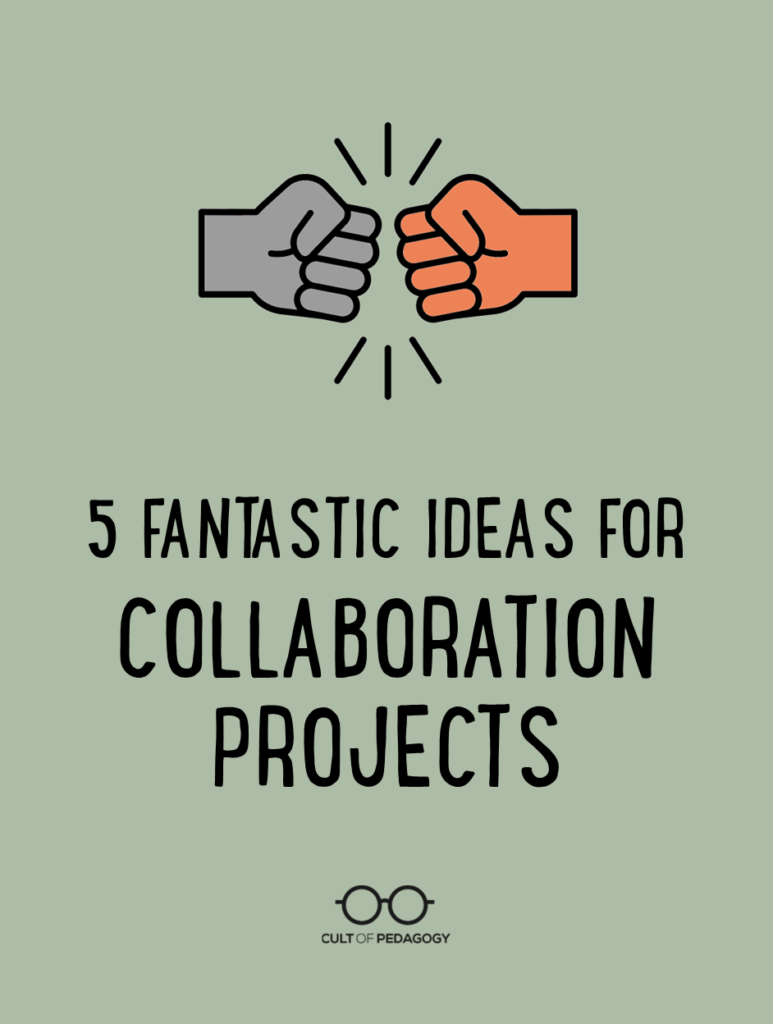
Listen to this post as a podcast:
Sponsored by CoderZ and Hapara
Collaboration has been a prominent topic in education for a long time. Those who recognize its importance regularly point out that working together to solve problems and create new things is a vital part of life, so it makes sense to practice it in school. Ideally, we’ll have students work together frequently, because the skills needed to make collaboration work well take a lot of practice.
One challenge teachers face in creating these opportunities is thinking up ideas for good projects. So I sent out a tweet asking for teacher-tested projects that went well and got students actually collaborating, not just dividing up the work. From those responses I chose five examples, and I’m presenting them here as broader project concepts — the goal is to give you five different options that you can customize for your content area. For each one, I’ve also offered a quick description of the technology the teachers in the examples used to facilitate their work.
Two Caveats
First, these projects are not strictly designed for collaboration. Any of them could be done as independent projects, but they happen to lend themselves well to groups, because each one naturally would be improved with contributions from more than one person.
Second, if you’re reading these and thinking, Aren’t these basically the same thing as project based learning? The answer is yes, kind of. There is a lot of overlap between inquiry learning, project based learning, problem based learning, and other structures that go beyond having students simply regurgitate content. Whether they fit a precise definition of PBL is up for debate; for the purposes of this collection, I’m less concerned about whether something fits a particular label and more concerned about providing ideas that can get your students collaborating authentically.
A Challenge for You: Adding Criticality and Agency
All of these ideas could be executed in a very straightforward way, where students simply put together information and present it in some final deliverable, but I want to challenge you to go further with them by adding layers of criticality and agency.
In her book, Cultivating Genius: An Equity Framework for Culturally and Historically Responsive Literacy, Gholdy Muhammad (who appeared on our podcast in 2020) defines criticality as “the capacity to read, write, and think in ways of understanding power, privilege, social justice, and oppression, particularly for populations who have been historically marginalized in the world … When youth have criticality, they are able to see, name, and interrogate the world to not only make sense of injustice but also to work toward social transformation” (120). Criticality is one of four key components of Muhammad’s model for teaching and learning that helps all students, especially those in the margins, “develop both personally and academically.” If you design your collaborative tasks so that students are challenged to do this kind of thinking, the project will be elevated into something that is not only more meaningful for students but also has the potential to dismantle the inequities so many teachers want to fight.
Then there’s agency, which is “the idea that people have the capacity to take action, craft and carry out plans, and make informed decisions based on a growing base of knowledge” (Safir & Dugan, 229). In other words, helping students learn how they can take action to improve their own lives and the lives of others. Student agency is a key priority in the Street Data approach, which we explored in 2021 with authors Shane Safir and Jamila Dugan. The authors’ incredible framework for school transformation is grounded in a pedagogy that gives students the tools “to become agents of their own learning and ultimately agents in the world.” Adding opportunities for students to practice agency in your collaborative projects is another way for you to teach not just academic facts and skills, but what students can do with those facts and skills in their real lives.
The examples offered here may or may not contain equal amounts of criticality and agency; they were not submitted with those ideas in mind. I’m adding this challenge not as a commentary on the examples, but rather a nudge to get you thinking along those lines for your own projects.
Idea 1: A Guide
Students create a guide that helps someone navigate a situation, environment, or process. Putting this guide together requires students to decide exactly what information to include, what to leave out, and how much detail to offer. Students could create a guide to getting started in a particular hobby, a guide to completing a process or task, or a guide to succeeding in a school, class, or other defined space.
Example: Voter’s Guide
Barry Frank, a Master Teacher in Flushing, Queens, NY, had his 12th-grade humanities students create a voter’s guide for an upcoming local election. Students researched local politicians who were up for election, who they were running against, and their platforms. “As journalists,” the project summary says, “students are responsible for gathering, evaluating, and verifying information along the way.” You can view a sample of student work here.
The Tech: “We used Spinndle as our co-learning space where students posted work at various checkpoints to the class feed,” Frank says. “They engaged in peer critique, iteration, and worked through problems through the platform. They also used Spinndle for project management, kind of like a Kanban. Instead of their work living in Google Drive silos, Spinndle offered a public collaboration space to work through the project. They also used the self-report feature to self-assess and reflect on their learning.”
Adding Criticality and Agency
Have students develop a guide that offers information to an underserved group in your community, region, or anywhere in the world, then take steps to publish and distribute that guide. The guide can help that group meet a specific need or help them grow in ways that might be more challenging for this group than for other groups. A guide like this should be put together only after interviewing and getting the input of members of the group to determine what kind of help they might need or aspirations they might want to fulfill. On the flip side, a different kind of guide could be written to teach those in power how to support the identified group more effectively.
Idea 2: A Local Research Project
Students research something about the history, science, government, or some other aspect of their local community, with in-person visits and interviews as a key component of their research. Topics could include things like drinking water quality, specific court cases, the impact of certain industries arriving in or leaving an area, how certain landmarks got their names, flora and fauna native to the area, or the history of immigration to the region.
Example: Listening to the Buddhists in Our Backyard
Under the supervision of their teacher Andy Housiaux and visiting teacher/author Chenxing Han, six high school students at Phillips Academy in Andover, MA, spent ten weeks immersed in the study of Buddhism in their local communities. Within 15 miles of their town there are 11 Buddhist temples: Cambodian, Lao, Thai, Vietnamese, and Chinese. Students visited these temples, used thinking routines from Harvard’s Project Zero, and learned to ask questions and do research in this immersive environment. After a week of these temple visits, students spent the remainder of their term researching themes that had emerged in their visits: the culture of mutual generosity between monastics and laypeople, cultural preservation and transmission in Asian American temple communities, and youth education. “We sought to map and better understand the tremendous diversity of Buddhism in America today,” Housiaux explained, “and to turn our attention toward often-overlooked Asian American communities (as opposed to a more typical focus on white convert communities in mainstream depictions of Buddhism).”
The team’s work is documented on this website.
The Tech: “Students used Slack for daily check-ins with each other and as a way to communicate during the day and over the duration of the project,” writes Housiaux. “Task management, delegation, and organizational matters were handled on Slack, which we used instead of an LMS. The students also used Google docs/slides/etc collaboratively, both in the research and writing process and when they were planning their final presentation. The final presentation was a public demonstration of learning over Zoom to 70 high school teachers, academics (a number of whom wrote books/articles that we had consulted over the term), members of our alumni community, and others interested in Buddhist education.”
Adding Criticality and Agency
If students embark on their research with the goal of helping a marginalized group by investigating a problem that needs solving, helping disconnected communities better understand one another, honoring a local person whose contributions may have been overlooked, or gathering opinions on a local issue, their project will prompt them to consider the people, places, and institutions of their daily lives through a more critical — and hopefully more participatory — lens. If they publish their research in a way that reaches and even impacts their community, even in small ways, the experience will build agency by teaching students how much influence a person can have through this kind of work.
Idea 3: A Tour
Students create and present an in-person, video-based, or virtual tour of a place. The term “place” can be broadly defined to include physical spaces near or far, virtual spaces, or even imaginary spaces, and can include commentary by the creators in writing, video, or audio format.
Example: Virtual School Tour
A group of sixth grade students in Rebecca Comninaki’s Innovations class (an elective) in Lynchburg, VA, had experienced how scary it was to attend a new middle school having never seen it — they hadn’t been able to tour the new school in person when they started. So they created this virtual tour of the school for future students. “They had hiccups in the beginning,” Comninaki says, “where they figured out which group members preferred to work on the tour, which students preferred to take pictures, and which of their original ideas needed to be reconsidered.” But they truly collaborated, and did so independently. “I cannot say enough about how little I did and how these students collaborated and worked during class, on weekends, and after school to get pictures of empty halls — all without me ever asking,”
The Tech: Although students didn’t use a collaboration platform for this project, they used a camera and app from GoPro to capture images of the school, then used ThingLink to put the tour together and make it accessible to viewers. The finished tour was shared as a VR goggle tour with incoming 5th grade classes in the spring to get students excited about middle school.
Adding Criticality and Agency
Rather than aiming for an objective capture of a place, tours can be created with deliberate subjectivity, with a goal in mind. That goal can be to empower the viewer (such as helping them locate places for assistance, accessible spaces for people with disabilities, LGBTQ+-friendly spaces) or to document a problem (such as virtually traveling the distance required to get to healthy food sources from certain neighborhoods — thanks to Colin Seale for sparking this idea). Once a tour has been created, students can take the next step in sharing it with the people who need to see it.
Idea 4: A Curated Collection
Here, students carefully select items that have something in common, then share them with a defined audience. This might look like a physical or virtual museum exhibit, a top ten list presented as a video, a list of the most, best, or worst of something, or a collection of stories, photos, or artifacts that represent some central idea. (For a few more suggestions, check out this list of curation project ideas.)
Example: Retrospective Video
Students in Marisa Thompson’s high school ELA class in California were tasked with creating a Year in Review video that showcased a selection of key moments in the past year built around a theme chosen by the student. In 2019, her students decided to work together on creating a Decade in Review video.
The Tech: Thompson allowed students to use whatever programs they knew to put the videos together.
Adding Criticality and Agency
Because curation requires us to represent larger ideas with a small selection, it does a great job of telling a story or sharing information in a way that can really grab the attention of the viewer. So one approach for using curation with criticality is to have students collect items that will raise others’ awareness of marginalized populations. One example of this is the Voice of Witness series of books that tells the stories of people whose voices are rarely heard. The same can be done with other forms of media, like you’ll find on the Global Oneness Project and the Disability Visibility Project. As students build their collections, they can also be thinking about the intended audiences for their collections, how they might get their work in front of them, and what kind of a change they might hope to inspire as a result.
Idea 5: A Solution
Students work together to develop a solution to a problem. The solution can be a physical product, a digital product, a prototype of some kind, or even an imagined or proposed item, plan, or system that solves a problem.
Example: App Development
High school students in Geoff Schmit’s software engineering class in Naperville, IL, had a whole semester to design their own app. This came after students completed AP Computer Science and an additional semester covering topics like engineering process and technology ethics. Schmit describes the process he used to structure the project in this blog post. One of the student-created apps that came out of this process is the Merry Tutor, a platform that matches volunteer tutors with students who need tutoring.
The Tech: Students used both Trello and Slack to manage their projects, but Schmit said Trello was the more critical of the two for the work. An example Trello board for the project can be viewed here.
Adding Criticality and Agency
Students can be tasked with solving problems that impact vulnerable populations or that perpetuate inequalities on small or large scales. Whether or not their solutions can actually be implemented should not discourage students from brainstorming them. As part of the solution development process, students can interview people who are most impacted by the problem and those in positions to implement solutions. They can also research the pathways taken by ordinary citizens to turn ideas for solutions into reality.
Making it all Work
- Any kind of collaboration can be full of potential pitfalls. Our tips for solving common cooperative learning problems can help.
- Marisa Thompson (who shared the retrospective video idea) wrote an article that offers tips from students on designing collaborative activities that work.
- PBLWorks has a great set of free collaboration rubrics that outline specific skills and standards that can guide you when teaching collaborative skills and giving students feedback on their work.
Do you have a great project idea to share?
If you’ve had a collaborative project your students really loved, tell us about it in the comments, and if you have a good online showcase of the project, feel free to share a link.
References
Muhammad, G. (2020). Cultivating genius: An equity framework for culturally and historically responsive literacy. Scholastic Inc.
Safir, S., & Dugan, J. (2021). Street data: A next-generation model for equity, pedagogy, and school transformation. Corwin.
Join our mailing list and get weekly tips, tools, and inspiration that will make your teaching more effective and fun. You’ll get access to our members-only library of free downloads, including 20 Ways to Cut Your Grading Time in Half, the e-booklet that has helped thousands of teachers save time on grading. Over 50,000 teachers have already joined—come on in.

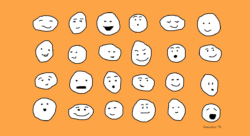
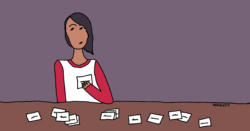
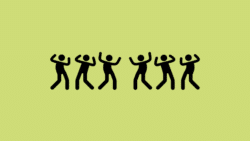
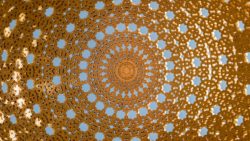
When I was teaching at the elementary level, a group of teachers formed MAPS – music, art, phys ed and Spark. We would create grade level projects that coordinated with subjects that were being taught. An exciting example was the Underground Railroad. In my art class we read a book about the Underground Railroad and how quilts were sometimes used as maps and safety symbols that were looked for. I had students gather in groups (with my help). We discussed how it must have been to not know anything beyond their immediate home and yard. I then read them different descriptions of a path each group had to take in order to make it to freedom. ex: carefully walking through an area that had snakes hanging from the trees (actually the climbing ropes in the gym). Each group collaboratively created their own maps. There were four 4th grades so the collected sections of maps were swapped with the other classes. An obstacle course was created in the gym and if the students collectively read the maps correctly, they made it through. In music class they learned many songs that were sung, Spark they learned about the safety symbols. It is something the children – now grown – speak fondly of.
Thanks for sharing this, Arlene. It’s always helpful to see how other teachers create meaningful learning experiences for their students outside of the prescribed curriculum.